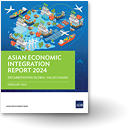Global Supply Chains Need Fixing: Help Is on The Way
Facing global supply chain challenges, the Indo-Pacific Economic Framework promotes economic cooperation among 14 economies, strengthening supply chain resilience, fostering innovation, and driving growth.
Supply chains – the vital global connections between the making of products and their delivery to customers worldwide – have been tested in recent years. They are increasingly vulnerable due to a lack of coordinated oversight and information sharing, inadequate investment for innovation and sustainability, increasing concentration on large trading partners, and a lack of mechanisms to manage crises.
Global supply chains promote investment and technology transfers, create jobs, and spread prosperity. But a series of shocks, including the COVID-19 pandemic, the Russian invasion of Ukraine and the continued deterioration of multilateral trade relations, have damaged the reliability of global supply chains. The next crisis can manifest differently, but the need to ensure the flow of critical goods such as food, energy, and medicines and avoid major supply chain disruptions will be the same.
One initiative that will bring a basket of solutions to the supply chain problems is the Indo-Pacific Economic Framework, a multilateral effort to build economic cooperation and integration for prosperity among the 14 countries of the Asia and Pacific region.
The framework – which includes Australia, Brunei Darussalam, Fiji, India, Indonesia, Japan, the Republic of Korea, Malaysia, New Zealand, Philippines, Singapore, Thailand, the United States, and Viet Nam – was launched in May 2022. It covers trade, supply chains, clean economy, and fair economy to enhance resilience, sustainability, inclusiveness, economic growth, fairness, and competitiveness.
On 27 May 2023, the 14 partners announced the substantial conclusion of negotiations on an agreement to strengthen supply chain security and resilience, which would have significant economic implications for the region and beyond.
The supply chain agreement includes creating a council to coordinate supply chain activities in critical sectors and goods such as semiconductors and critical minerals; forming a crisis response network to share information and prepare crisis responses; and establishing a labor rights advisory board to promote skills training and development in critical sectors while ensuring labor rights.
It also presents new economic opportunities for the region through greater collaboration on logistics and connectivity; more investment in critical sectors; and coordinated emergency preparedness and responses to mitigate supply chain disruptions. By improving the security and resilience of supply chains, businesses will be more confident in investing in the region and engaging in cross-border trade.
One initiative that will bring a basket of solutions to the supply chain problems is the Indo-Pacific Economic Framework, a multilateral effort to build economic cooperation and integration for prosperity among the 14 countries of the Asia and Pacific region.
Increased investment and trade will create more job opportunities and drive regional economic growth. Moreover, the supply chain agreement could stimulate innovation in the region. By promoting collaboration among partner governments with technical and financial assistance, the agreement can help to foster innovative solutions to supply chain challenges, further driving economic growth and competitiveness. Another economic impact is the potential for increased efficiency and cost savings by allowing businesses to manage supply chain risks better and reduce costs associated with disruptions and delays.
On the trade front, the supply chain agreement is expected to help reduce concentration and reliance on a few large trading partners for critical goods and minerals. For example, about 60% of Indo-Pacific Economic Framework members’ imports include semiconductor chips in the products or the production process, if not the chips themselves.
But about 75% of the global installed capacity for semiconductor chips is concentrated in East Asia. Silicon and gallium used in chip production are also concentrated in a small number of producers.
The Indo-Pacific Economic Framework can also catalyze investment by expanding and diversifying foreign direct investment in the region. For example, Southeast Asian economies witnessed a sharp growth in investment in manufacturing driven by key industries such as electronic vehicles, electronics, biomedicals and pharmaceuticals.
Significant developments in these industries and the rise of the digital economy would create new segments of value chains, expanding regional production capacity and networks in the coming years. The Indo-Pacific Economic Framework also prompts discussion on how foreign direct investment can expand its role in integrating the production network and deepen regional value chains to increase supply chain resilience.
The resultant reconfiguration of global supply chains can be conducive to the transformation of Asia’s developing economies towards more innovative, resilient, and sustainable societies. Members of the Association of Southeast Asian Nations are expected to benefit from increased trade and transformative foreign direct investment in electric vehicles, semiconductors, and digital infrastructure. To harness the potential benefit, these economies should focus on efficient logistics and infrastructure connectivity, streamlining investment procedures and regulatory requirements, information provision, and transparency.
While the framework is not a typical free trade agreement, with no binding commitments on tariff reductions and market access, increased cooperation and development support can generate tangible benefits for developing Asian members. That being said, it still has a long way to go.
Supply chain is only one of the framework’s four pillars. The remaining three pillars cover much more complex and geopolitically sensitive issues such as digital trade rules, cross-border data flows, labor and environmental standards. Larger benefits are expected in the areas of green and digital agreements.
The benefits of any agreement can only be obtained when and if the members make concerted efforts to address difficulties in the implementation, facilitate transformative reforms, and mobilize official and private investment where needed. For example, specific to the supply chain agreement, IPEF members must commit to coordinated efforts to improve mapping, transparency, and information exchange on the supply chain.
Moving forward, the success of The Indo-Pacific Economic Framework will depend on its ability to advance the rules and standards across supply chains, digital trade, environment, and labor that go beyond broad principles and goals.
Original article was published at the Asian Development Blog and duplicated here with permission from the author. *




